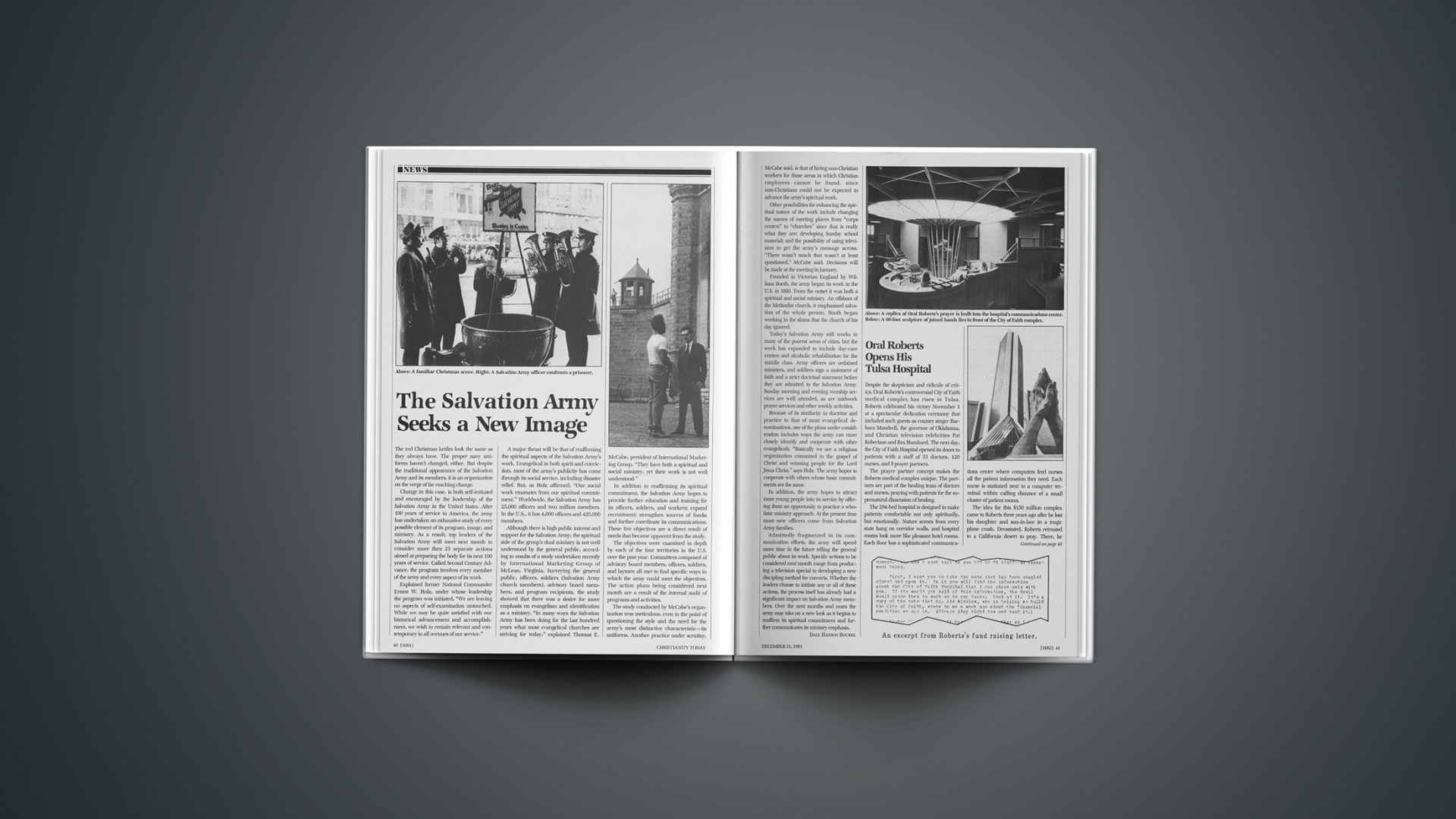Despite the skepticism and ridicule of critics, Oral Roberts’s controversial City of Faith medical complex has risen in Tulsa. Roberts celebrated his victory November 1 at a spectacular dedication ceremony that included such guests as country singer Barbara Mandrell, the governor of Oklahoma, and Christian television celebrities Pat Robertson and Rex Humbard. The next day, the City of Faith Hospital opened its doors to patients with a staff of 33 doctors, 120 nurses, and 9 prayer partners.
The prayer partner concept makes the Roberts medical complex unique. The partners are part of the healing team of doctors and nurses, praying with patients for the supernatural dimension of healing.
The 294-bed hospital is designed to make patients comfortable not only spiritually, but emotionally. Nature scenes from every state hang on corridor walls, and hospital rooms look more like pleasant hotel rooms. Each floor has a sophisticated communications center where computers feed nurses all the patient information they need. Each nurse is stationed next to a computer terminal within calling distance of a small cluster of patient rooms.
The idea for this $150 million complex came to Roberts three years ago after he lost his daughter and son-in-law in a tragic plane crash. Devastated, Roberts retreated to a California desert to pray. There, he says, God commanded him to unite the healing streams of prayer and medicine in a trinity of triangular skyscrapers: one, a 30-story hospital; another, a 60-story medical clinic; and the other, a 20-story research center.
The Tulsa Area Hospital Council strongly opposed Roberts’s plan. It claimed Tulsa already had too many unused hospital beds. Other opponents said the City of Faith would further add to Tulsa’s doctor shortage by hiring away physicians.
The battle between Roberts and his critics continued all the way to the Oklahoma Supreme Court. Meanwhile, Roberts’s medical towers were rising. In the midst of construction, he said he saw in a vision a 900-foot Jesus who encouraged him by saving the hospital would be built through the contributions of donors. Critics snickered, but the faithful kept donating, and by the time the state supreme court handed down its opinion, it was a moot point. The court granted Roberts a permit.
Still, some area doctors are not happy with Roberts’s two-million-square-foot complex. C.T. Thompson, a Tulsa surgeon, says doctors don’t like the “miracle-a-day” image Roberts is giving the Tulsa medical community. Thompson says the hospital is unnecessary and that the city can’t handle the type of patient he expects it to attract. He says “all the social services of the city will be sopped up to take care of the poor and unwashed who arrive in search of miracles.”
But James Winslow, chief executive officer of the hospital, says the City of Faith will take care of its share of indigent patients and “will not knowingly refuse anyone health care because of his lack of ability to pay.”
Roberts used a crass mass-mailing gimmick to get people to contribute to his hospital during the fall. He mailed computer-printed letters to patrons asking them not to breathe a word to anyone about the contents of a highly confidential note from Winslow to Roberts, copies of which accompanied the letters. The awful contents of Winslow’s note: the hospital was due to open in 30 days, and not enough money was in hand. Yet by faith, Winslow told Roberts, he had gone ahead and ordered equipment for the hospital.
Roberts expects his center to attract more than his miracle-believing three million supporters. He says he believes the City of Faith could become the “Mayo Clinic of the Southwest,” with the most advanced technology and medical research available. The research center will specialize in cancer, heart disease, and aging. On the City of Faith’s dedication day, Roberts declared that God was about to give a cure for cancer, which he calls a mysterious, satanic disease. He said he hoped his research center would be a part of that discovery.
Roberts knows his City of Faith has a long way to go before it can match Minnesota’s Mayo Clinic. To complete the center, he still needs another $130 million from his supporters, a sum he expects to have by 1988. At that time, Roberts’s plans call for 777 beds and a total of 4,000 staff members, including 318 doctors and 800 nurses.










